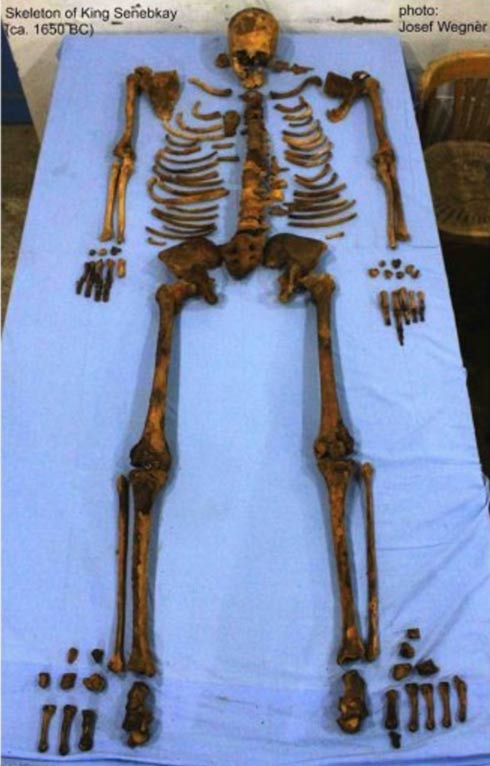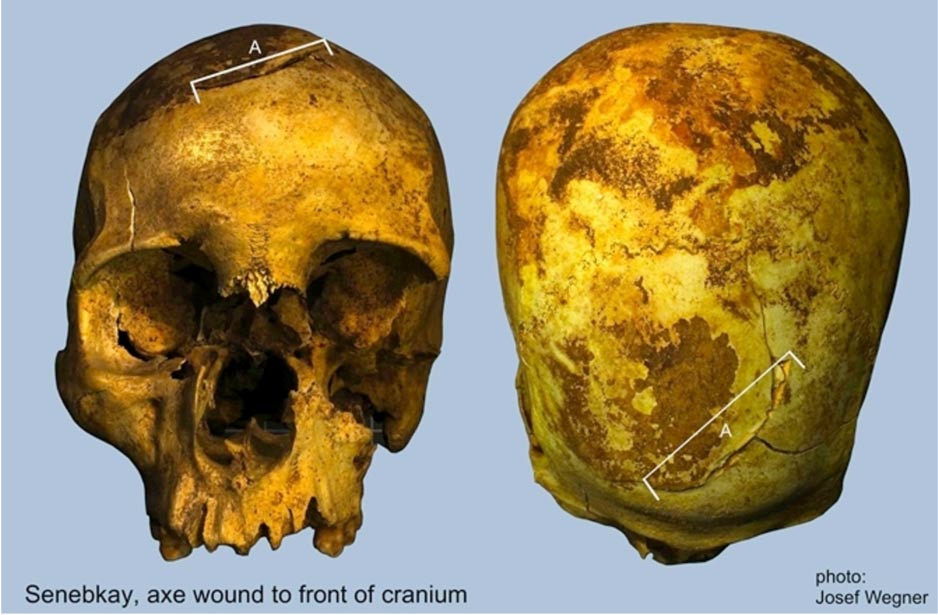3,600-year-old bones of king Senebkay show Egyptian pharaoh met brutal end
King Senebkay, pharaoh during the Abydos Dynasty, was brutally killed during a fierce battle, researchers believe, and his remains were returned home to be mummified long after his death.
Dr. Josef Wegner, associate director of Egyptian archaeology at the University of Pennsylvania and his team discovered the remains in South Abydos, Sohag province, Egypt last year. The body was discovered in a wooden coffin inside a four-chamber tomb. Senebkay’s mummified remains had been ripped apart by robbers in antiquity, but archaeologists were able to piece the mummy together and complete a full forensic analysis.
The research team determined that Senebkay was 1.72 to 1.82 meters (5’9″ to 6 feet) in height, and was 35 to 40 years of age at the time of death. His bones revealed a “shocking” number of wounds, thought to have been caused by collective attacks, reports DiscoveryNews.
MORE
- New Pharaoh Discovered In Egypt – Introducing King SenebKay
- Earliest bronze dagger ever found in Britain rediscovered with ancient chieftain
- Identifying an Ancient Battle and Dating the Song of Deborah
Catastrophic skull injuries indicated that various weapons, including axes, were used in what appears to have been a great battle.
Dr. Wegner tells DiscoveryNews, “The king’s skeleton has 18 wounds that penetrated to the bone. The trauma includes major cuts to his feet, ankles, and lower back. Multiple blows to Senebkay’s skull show the distinctive size and curvature of battle axes used during Egypt’s Second Intermediate Period.
“His assailants first cut his lower back, ankles and feet to bring him to the ground and then finished him with axe blows to the skull,” he concludes.
Reconstruction of the pharaoh’s final moments through bone analysis suggests he was on a horse when he was attacked and brought down. According to International Business Times, Wegner says the mummy’s leg bones and pelvis indicated he had been a lifelong rider, and that horseback riding may have played an increasing role in military campaigns during the Abydos dynasty, before chariot technology had been adopted.
Wegner and his colleagues cannot say for certain who slayed Pharaoh Senebkay - whether it was northern Hyksos kings, or southern Egyptian enemies. It has been determined, however, that he was probably far from home when he died, as his remains were not mummified until a long time after his death.

The skeleton of Pharaoh Senebkay. Credit: Ministry of Antiquities
The skeleton of king Senebkay was uncovered in 2014 to the excitement of researchers. Never before heard of in ancient Egyptian history, king Senebkay's name was found inscribed in hieroglyphics written inside a royal cartouche - an oval with a horizontal line at one end signaling a royal name.
"This was the first time in history to discover the king," said Ali Asfar, Head of Antiquities for the Egyptian government.
According to Ministry official Ayman El-Damarani, king Senebkay ruled Egypt for four and a half years, the longest reign of his time. It is believed he may have been the first to rule Egypt at the beginning of the 13 th Dynasty, a little understood period of history. Historians have not yet pieced together its beginning and end, nor established who ruled when.
DiscoveryNews writes that, “Senebkay, whose name means ‘my spirit is healthy,’ appears to belong to a short-lived kingdom, the Abydos Dynasty dating ca. 1650-1600 BC. At that time central authority collapsed, giving rise to several small kingdoms.”

The cartouche of a newly discovered pharaoh, Woseribre Senebkay, inside the king’s burial tomb. Public Domain
The sacred city of Abydos was a necropolis for early Egyptian royalty. The many temples were used from prehistoric to Roman times. Excavations, such as the one which discovered Senebkay, continue at the ancient site.

A view down the axis of the hypostyle hall of the temple of Seti I at Abydos, Egypt. Credit: Irene Soto/Flickr
Featured Image: Fatal wounds to the front and back of the skull thought to be caused by axe blows. Credit: Josef Wegner.
By Liz Leafloor



















Comments
Egyptians (some) have for centuries looted, plundered and pillaged tombs, necropoli and pyramids in search of valuables. IT seems to me that just as certain ideas in physics and biology are being questioned, that this entire scenario be brought into question.
Everybody is accepting the lineages and the mummified remains of plundered tombs as genuine, just as the germans became the nazis under the false ideas and the influence of Hitler. Lineages of degree-laden diggers have followed one another into the dust and distant mists of time, dust and sand, on the assumption that these mummys are more important than other buried bodies.
They resurrect their entirely worthless remains, they scrabble in the dust and greedily, arrogantly assure any captive audience in museums and on TV that this skeleton, found in a plundered tomb in the middle of nowhere, is a dead kings body, and so worthy of our attention, and they then obtain, fraudulently in all cases, millions of dollars to equip and research said bones, rather than care for the living around them or do something less unhygeinic and bizarre with their odd lives!
There is no proof possible or necessary that these are the bones of a dead king. No proof is needed. Their mere word is enough. But even supposing they obtain useable DNA, even supposing they are able to link this DNA directly and genuinely to another worthless bag of bones somewhere else, so what?
They have zero cultural or historic value, unlike the artifacts produced elsewhere by that culture, so why make such a big deal out f it. Why any interest at all?
It’s a Business, like Banking or Cosmetics. It’s the pastime of rich decadent cultures with “nothing better to do”. Maybe yes. But is it not also a fall from grace and objectivity too, as those plundering such tombs in ancient times almost certainly replaced the mummies they plundered with others lying about that were nothing more nor less than those placed in the tomb to guard their “Master”.
Does nobody even question the intelligence of a people who mummified everything and anything they could get their hands on? Whilst celebrating what their artists and architects did quite rightly, shouldn’t we see their priests as the ignorant charlatans they certainly were, and their kings and queens as their victims, suckers to worthless rituals and beliefs, just as so many of our current superstitions are??
In an age where there are frequent visions in the heavens that establish for all the existence of the unseen, isn’t it time we left the past alone and concentrated on enjoying and improving present realities?